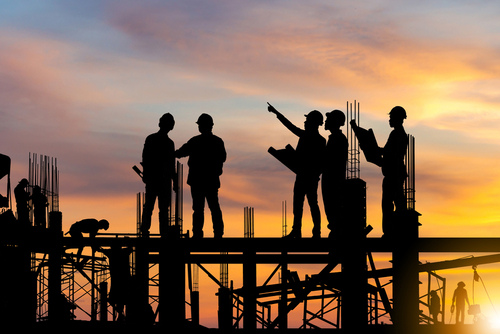The need for new buildings and facilities is soaring, buoyed by surging demand for everything from manufacturing to clean energy infrastructure and the triumvirate of legislation making construction more cost-effective, including the Infrastructure Investment and Jobs Act (IIJA), the Inflation Reduction Act (IRA), and the Creating Helpful Incentives to Produce Semiconductors (CHIPS) Act.

While this is great for the building industry, the design of any new construction must be carefully considered by the long-term facility owners and operators whose use of the buildings has an immense environmental impact.
2024 will produce a wave of new construction with enormous climate implications. Today’s new construction will leave a legacy lasting generations. As environmental sustainability, health, and well-being become critical components of the built environment, 2024 is poised to be a breakthrough year for green construction.
With the global building floor area expected to double by 2060, even small changes can make an outsized impact.
Here are three ways that today’s facilities management leaders can work with their counterparts in the built environment to ensure their structures operate in a way that’s more environmentally sustainable from the ground up.
1. Prioritize Green Building Plans
Greener facilities in the future begin with better building process plans today. Facilities managers and their construction partners have ample reasons to get this right.
The IRA is funding and incentivizing a more sustainable approach to constructing our built environment. It will enable engineers, designers, builders, and buyers to better align their facilities with needed environmental outcomes.
Specifically, the IRA includes provisions for tax incentives and grants that support the use of renewable materials and energy-efficient technologies in new construction and renovations. This legislative push is expected to significantly reduce buildings’ carbon footprints by promoting the integration of solar panels, green roofs, and improved insulation materials.
At the same time, the latest Leadership in Energy and Environmental Design (LEED) standards, the most widely used green building rating system globally, provide a framework for creating healthy, efficient, and cost-saving green buildings. Developed by the U.S. Green Building Council to evaluate and certify sustainable buildings, LEED standards have been applied to 197,000 building projects globally, reaching 186 countries and territories.
LEED v5 is the latest version of these standards, updating the global benchmark to align with the Paris Climate Accord’s 2030 and 2050 targets while addressing issues of equity, health, ecosystems, and resilience in the built environment. As the USGBC explains, LEED v5 looks to:
- Decarbonize the building industry.
- Inspire, recognize, and adapt resilient built environments.
- Invest in human health and well-being.
- Achieve equitable outcomes for all stakeholders.
- Support flourishing ecosystems through regenerative development practices.
Facilities managers can create green building plans today that will make tomorrow more sustainable by working closely with construction partners.
2. Adapt to Changing Building Codes and Design Requirements
In late 2023, California entered a new era of corporate responsibility by signing S.B.253 and S.B.261 into law.
Known as the Climate Accountability Package, the state laws require many companies in California to disclose greenhouse gas emissions and climate-related financial risks, increasing transparency and accountability requirements with potential implications for companies, including those in the construction sector, globally.
By mandating the disclosure of carbon emissions, the legislation effectively integrates environmental responsibility into the corporate governance framework, compelling companies to adopt more sustainable practices or face significant financial penalties.
California’s Climate Accountability Package signals a paradigm shift with national implications in corporate accountability and provides a functional framework for proactive adoption. This includes using technology to track all metrics, embracing green building certifications like LEED, and engaging with the community and stakeholders to mitigate climate impact and promote holistic community development, health, and well-being.
This isn’t necessarily a new trend.
For instance, the American Recovery and Reinvestment Act (ARRA) of 2009 included a significant investment in updating building codes, allocating $3.4 billion in grants to states and localities to update their building codes to be more energy-efficient.
Facilities managers can’t expect that regulators will leave their built environment untouched. Instead, they should see state regulations, like those in California, as a sign of the times with national implications.
3. Adopt Better Building Materials
Common building materials, including steel and cement, are among the most used substances on Earth and serve as the backbone of the built environment. The production of these materials is also energy-intensive, emitting greenhouse gases in the process.
According to one analysis, the cement industry alone is responsible for 8% of carbon dioxide emissions. The steel industry is close behind, accounting for 7% of global carbon dioxide emissions.
A McKinsey & Company report identifies several possible cement enhancements that would reduce the product’s climate impact, including replacing the clinker with ground-granulated blast furnace slag, silica fume, or natural pozzolanic, which could “mitigate up to 90 percent of cement’s carbon footprint.”
Exploring and integrating better building materials, including those that are recycled or can be produced with minimal environmental impact, can meaningfully reduce a building’s carbon footprint, making the construction process and built environment structure more environmentally friendly.
Conclusion
The environmental stakes are equally high as the construction sector experiences significant growth, driving new facilities to be built today that will impact the communities around them for decades to come.
The right commitments, priorities, and processes can make a meaningful impact, allowing facilities to operate more sustainably, efficiently, and effectively than ever before by ensuring they’re designed and built with green infrastructure that will resonate for generations.

Tommy Linstroth is the founder and CEO of Green Badger, a SaaS provider simplifying sustainability and ESG in the built industry.
